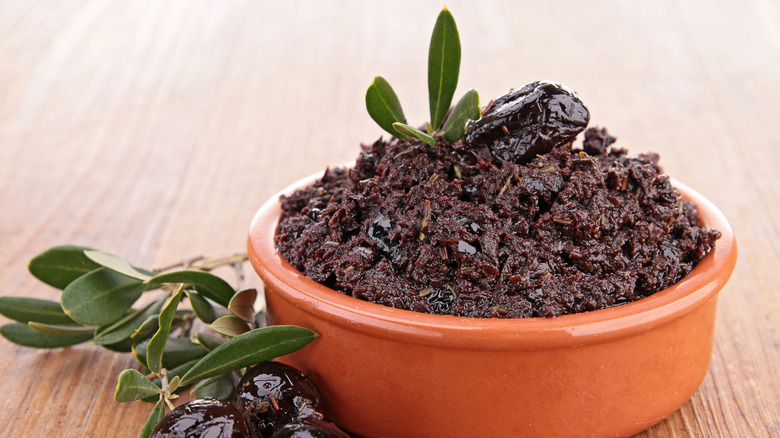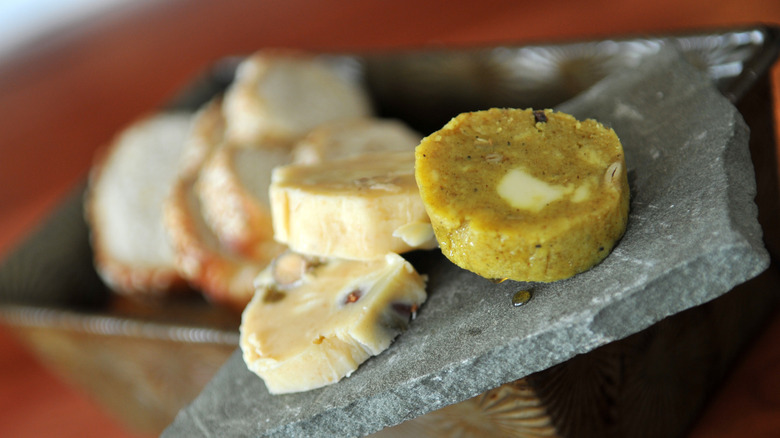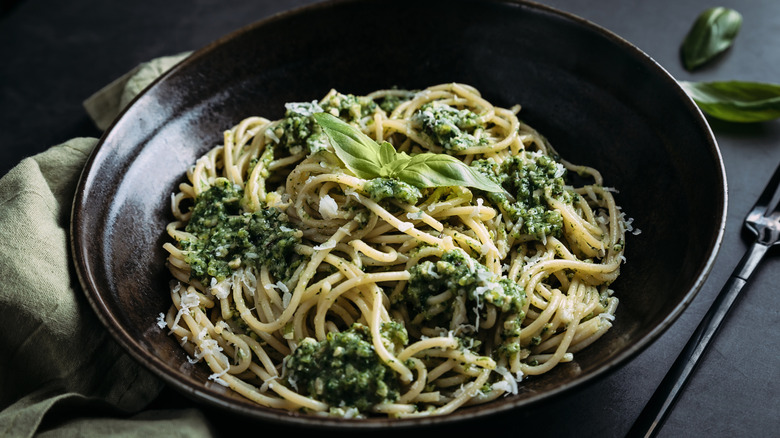4 Out-Of-The-Box Ways To Use Olive Tapenade
Briny, tangy, earthy, and ancient, olive tapenade is an oft-ignored condiment that deserves a lot more use and a lot more recognition. Beloved by culinary maven Martha Stewart, olive tapenade hails from the Provence region of France and dates back to 1880, when a chef in Marseille named Meynier created it at a restaurant called La Maison Dorée. Though many believe tapenade to be a dominantly olive paste, the truth is that the original recipe was more equal parts olive, anchovy, and caper.
There are, obviously, tons of ways to approach creating a tapenade these days. You can use French Niçoise olives, drained briny olives, or pitted green olives, blending your preferred variety with oil-packed tuna and/or anchovies, a squirt of lemon, capers, garlic, and fresh herbs. Whatever you choose, keeping this Mediterranean spread on hand is definitely useful. Here are four out-of-the-box ways to use olive tapenade.
Make a compound butter
Remember butter boards? They were a hot commodity for about five minutes — adorable hors d'oeuvres boards where folks spread beautiful, rich, yellow butter on charcuterie boards and adorned them with dippables from bread to fresh radishes. In my opinion, these boards didn't go far enough into Imaginationland, and those smeared butters could have hugely benefited from the addition of an olive tapenade. On that same wavelength, you can use your freshly made tapenade as part of a deliciously rich compound butter. Compound butters are just that — butter mixed with other ingredients, be it garlic and herbs, miso, gorgonzola or bleu cheese, sweet items like maple or candied oranges, etc. The possibilities are endless.
To create an olive tapenade compound butter, simply allow your salted or unsalted (completely up to your taste) butter to soften. Once it does, combine it with your olive tapenade, roll into a log, and chill until it firms up. You can use your tapenade compound butter on everything from simply grilled sourdough bread to a NY strip.
Use it as a pizza base
Pizza seems to have become an uncharted and wild adventure lately, with all manner of things added as toppings. Without starting the pineapple debate (or the more upsetting banana debate), we can, calmly and rationally, discuss the possibility of changing up your pizza base. There's already a precedent set for swapping red sauce for a white base, such as ricotta or even mascarpone. You can also just go with garlic and olive oil on your crust if you're cooking up a vegetable or salad pizza. But one thing you definitely haven't tried — and should — is using your olive tapenade as the base.
Olives are already fairly at home on a pizza, so spreading this condiment on your pie isn't that outlandish. You can start one of two ways. First, you could bake your crust first and add the tapenade after it's out of the oven. Doing so will ensure your tapenade doesn't dry out. However, doing so also limits your toppings to items that don't need to be hot, such as a pile of dressed Caesar salad or arugula tossed with lemon, olive oil, and Parmesan shavings. You could even leave the tapenade alone, having it be the sole topping on your pizza dough. The second option is, of course, using the tapenade as you would a red sauce — topping it with mozzarella, mushrooms, and whatever else your heart desires.
Create a unique pasta dish
Hot, buttered pasta is a favorite in my house, mostly because it keeps my 5-year-old and 1-year-old from turning feral. When I'm feeling fancy, I'll take the leftover cooked pasta and toss it with garlic, fresh herbs, good olive oil, fresh cracked black pepper, and a healthy amount of Parmesan cheese for my husband and me to scarf down later. But, having a jar of prepped and ready-to-eat olive tapenade on hand could give the same briny, satisfying bite to our pantry pasta while upping the culinary game.
You can go a few routes here. Simply adding a few spoonfuls of prepared tapenade to your cooked pasta along with good olive oil, fresh herbs, and perhaps a bit of sautéed garlic is perfectly acceptable. You can, however, also add tapenade to already prepared sauces. It'll give red sauce a complex and briny punch and can bring a new level of earthiness to pestos and white sauces.
Add it to your eggs
Soft and luscious scrambled eggs or fancier omelets stuffed with all manner of fillings are both go-tos for breakfast for me and many other folks. Toppings and add-ins for eggs seem to be pretty predictable: a Mexican omelet with salsa, avocado, and cheese; a French-inspired plate with chèvre and ham; or a Greek version with spinach and feta. All of those are delicious in their own right, but tapenade seems to have never quite made the cut as an egg dish inclusion. However, adding the olive and caper accoutrement is a pleasant eating experience in its own right.
If you're cooking scrambled eggs, try mixing a spoonful of tapenade into the still-uncooked eggs. The tapenade will warm, its oils melting lusciously into the mixture — giving you a savory bite perfect on a piece of milk bread or alongside a croissant. For the omelet treatment, add tapenade on its own or with other Provence-style ingredients, such as oil-packed tuna, spinach, and fresh haricots verts.




